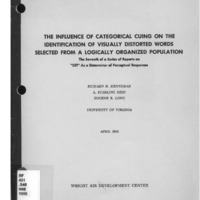-
Title
-
The Influence Of Categorical Cuing On The Identification Of Visually Distorted words Selected From A Logically Organized Population
-
Date
-
1954
-
Index Abstract
-
Not Available
-
Photo Quality
-
Not Needed
-
Report Number
-
WADC TR 54-362
-
Creator
-
Henneman, Richard H.
-
Long, Eugene R.
-
Reid, L. Starling
-
Corporate Author
-
Virginia U.
-
Laboratory
-
Aero Medical Laboratory
-
Extent
-
19
-
PB Number
-
PB129569
-
Identifier
-
AD0085567
-
Access Rights
-
ASTIA
-
Distribution Classification
-
1
-
DTIC Record Exists
-
No
-
Distribution Change Authority Correspondence
-
AFAL LTR
-
Distribution Conflict
-
Fix
-
Abstract
-
In air communication the identification of ambiguous message signals is substantially aided by operator familiarity with the message population and by the high degree of contextual redundancy present. Previous laboratory research on perceptual setting as an aid to the identification of ambiguous messages has ignored the factors of familiarity and contextual organization. The present experiment constituted an attempt to learn whether further response restriction in the form of setting cues would facilitate the recognition of visually distorted words drawn from a logically organized population, when subjects were familiar with the word categories and the specific words. Experimental variables were (1) degree of categorical restriction (in cuing) (2) type of familiarization (categories only or categories plus specific words), and (3) temporal position of the setting cues (before or after stimulus presentation). Principal findings were: (1) Increases in categorical restriction led to improved identification. (2) Familiarity with specific words, apart from a knowledge of the word categories, siginficantly improved identification. (3) Temporal position of cuing was not a significant factor. These results imply the probable helpfulness of setting cues for the identification of ambiguous messages in operational situations where familiarity and context have already markedly restricted the operator's responses.
-
Report Availability
-
Full text available
-
Date Issued
-
1955-04
-
Provenance
-
Hunt Library, Embry-Riddle Aeronautical University
-
Type
-
report
-
Format
-
1 online resource
 WADCTR54-362.pdf
WADCTR54-362.pdf